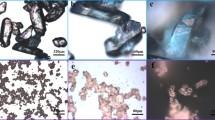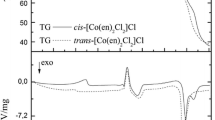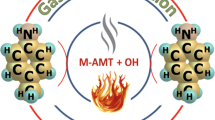Abstract
A mechanism for the thermal decomposition of ionic oxalates has been proposed on the basis of three quantitative relationships linking the quantitiesr c/r i (the ratio of the Pauling covalent radius and the cation radius of the metal atom in hexacoordination) andΣI i (the sum of the ionization potentials of the metal atom in kJ mol−1) with the onset oxalate decomposition temperature (T d) (Eq. 1) the average C-C bond distance (¯d) (Eq. 2), and the activation energy of oxalate decomposition (E a) (Eq. 3):
On the basis of these results it is proposed that the thermal decomposition of ionic oxalates follows a mechanism in which the C-O bond ruptures first. From Eq. 3 it is further proposed that strong mutual electronic interactions between the oxalate and the cations restrict the essential electronic reorganization leading to the products, thereby increasingE a.
Zusammenfassung
Ein Mechanismus der thermischen Zersetzung ionischer Oxalate wurde auf der Grundlage von drei quantitativen Zusammenhängen vorgeschlagen, welche die Mengenr c/r i (Verhältnis des Paulingschen kovalenten Radius und des Kationenradius des Metallatoms in Hexakoordination) undΣI i (die Summe der Ionisierungspotentiale des Metallatoms in kJ Mol−1) mit der anfänglichen Zersetzungstemperatur (T d) (Gleichung 1), der durchschnittlichen Entfernung der C-C Bindungen (d) (Gleichung 2) und der Aktivierungsenergien der Oxalatzersetzung (E a) (Gleichung 3) verbinden.
Aufgrund ihrer Ergebnisse ist der Verfasser der Ansicht, daß bei der thermischen Zersetzung von ionischen Oxalaten ein solcher Mechanismus verläuft bei welchem die C-O Bindung als erste aufgerissen wird. Sie vermuten auf Basis der angegebenen Gleichung (3), daß die sehr starke Elektroneninteraktion zwischen dem Oxalation und dem Kationen jene bedeutende Elektronenumgestaltung die zur Bildung des Produkts führt beschränkt und derartE a erhöht ist.
Резюме
Предложен механизм т ермического разложе ния ионных оксалатов на о снове трех количественных соотношений, связыва ющихr c/r i (отношение ковалентн ого радиуса по Полижу к радиусу ме талл-катиона в шестикоординационн ом состоянии) и∑I i (сум ма ионизационных потен циалов атома металла, выраженная в кдж/моль) с начальной температуройT d разложения оксалат а (уравн. 1), со средним расстоянием связи C-C (¯d) (уравн. 2/и энергией акти вацииE a реакции разло жения оксалата (уравн. 3)
Предположено, что тер мическое разложение ионных оксалатов протекает по механизму, где сначала происход ит разрыв C-O связи. На ос новании уравнения 3 выдвинуто дальнейшее предположение, что со вместное сильное эле ктронное взаимодействие межд у оксалат-ионом и катио ном металла существе нным образом ограничивае т электронную перегруппировку, при водящую к продуктам р еакции, вследствие чего увел ичиваетсяE a.
Similar content being viewed by others
References
I. A. Kahwa andA. M. Mulokozi, J. Thermal Anal., 21 (1981) 61.
L. Pauling, J. Am. Chem. Soc. 69 (1947) 542.
R. D. Shannon andC. Prewitt, Acta Cryst. B. 25 (1971) 925.
H. G.Aylward and J. J. V.Findlay, SI Chemical Data 2nd Ed. 1974, John Wiley.
B. Beagley andW. H. Small, Acta Cryst., 17 (1964) 783.
M. M. Factor andR. Hanks, J. Inorg. Nucl. Chem., 31 (6) (1969) 1649.
G. A. Jeffrey, J. Am. Chem. Soc., 76 (1954) 5283.
D. J. Hogson andJ. Ibers, Acta Cryst., B 25 (1969) 469.
B. F. Pederson, Acta Chemica Scand., 19 (1965) 1815.
C. Sterling, Acta Cryst., 19 (1962) 917.
J. C.Martin, A.Aubry, G.Bertrand, G. E.Joly, J.Protas and J.Wyatt, Acad. Soc. Paris, (1964) t. 278 serie C-1001.
C. Sterling, Nature, 208 (1965) 588.
R.Deyrieux and A.Peneloux, Bull. Soc. China. France, (1969) 2575.
R.Deyrieux, C.Barre and A.Peneloux, Bull. Soc. Chim. France, (1973) 25.
Garaj andG. Lundgreen, Collection Czechoslov. Chem. Commun. 42 (1977) 210.
W.Ollendorf, Ph. D. Thesis Munich (1968) and W. Ollendorff and F. Weigel, Inorg. Nucl. Chem. Lett., 5 (1968) 264.
E. Hansson, Acta Chemica Scand., 24 (1970) 2969.
E. Hansson, Acta Chemica Scand., 27 (1973) 823.
E. Hansson, Acta Chemica Scand., 26 (1972) 1337.
M. Jaber, R. Fauze andH. Loiseleur, Acta Cryst., B 34 (1978) 429.
M. V. Viswamitra, J. Chem. Phys., 37 (1962) 1408.
A. Kobayashi, V. Sasaki andH. Kobayashi, Bull. Chem. Soc. Japan, 52 (1979) 3682.
H. Schulz, Acta Cryst. B 30 (1974) 1318.
M. B. G. Drew andD. J. Eve, Acta Cryst B 33 (1977) 2919.
T. R. R. McDonald andJ. M. Spink, Acta Cryst., 23 (1967) 944.
S. Hugo andB. D. George, Inorg. Chem., 9 (1970) 2112.
D. Taylor, Austr. J. Chem., 31 (1978) 1455.
B. C. Dalzell, K. J. Eriks andV. Eldik, J. Am. Chem. Soc., 93 (1971) 4298.
G. J. Kruger, E. L. J. Breet andV. Eldik, Inorg. Chim. Acta, 19 (1976) 151.
M. N. Akhtah andA. J. Smith, Acta Cryst., B 31 (1975) 1361.
G. L. Glen, J. V. Silverton andJ. L. Hoard, Inorg. Chem., 2 (1963) 250.
L. Pauling, The Nature of the Chemical Bond, Cornel University Press, Ithaca, New York (1960) Pg. 233.
D.Dollimore and D.Tinsley, J. Chem. Soc., (1971) 3043.
K. O. Hartman andI. C. Hisatsune, J. Phys. Chem., 71 (1961) 392.
C. Dragulescue, P. Tribunescu andI. Menessy, Rev. Roum. Chim., 12 (1967) 389.
M. S. Subramanian, R. N. Singh andH. D. Sharma, J. Inorg. Nucl. Chem., 16 (1959) 3789.
A. Glasner andM. Steinberg, J. Inorg. Nucl. Chem., 16 (1959) 279.
V. V. Dolzov, V. G. Ulasov andV. N. Shalaginov, Zh. Prikl. Khim., (Leningrad) 46 (1973) 251.
A. Glasner, E. Levy andM. Steinberg, J. Inorg. Nucl. Chem., 26 (1964) 1143.
A.Glasner, E.Levy and M.Steinberg, 25 (1963) 1119.
V. M. Padmanabhan, S. C. Saraiya andA. K. Sundram, J. Inorg. Nucl. Chem., 12 (1960) 356.
Author information
Authors and Affiliations
Additional information
Excerpt from a Dissertation by I. A. Kahwa in fulfilment of the requirements for the degree of M. Sc. at the University of Dar es Salaam.
The authors wish to thank the University Research and Publications Committee which enabled them to carry out the preliminary studies, and The University Staff Development Committee for financial assistance to I. A. Kahwa.
Rights and permissions
About this article
Cite this article
Kahwa, I.A., Mulokozi, A.M. The mechanism of thermal decomposition of ionic oxalates. Journal of Thermal Analysis 24, 265–271 (1982). https://doi.org/10.1007/BF01913680
Received:
Issue Date:
DOI: https://doi.org/10.1007/BF01913680




